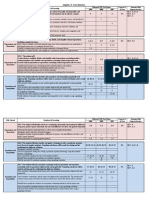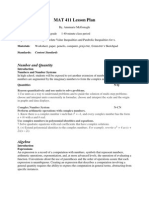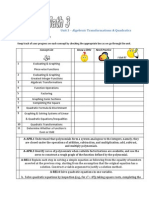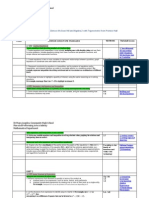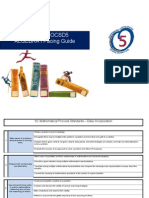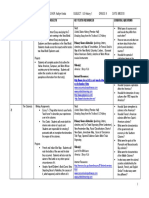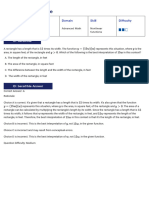PLD Algebra II
PLD Algebra II
Uploaded by
api-310256368Copyright:
Available Formats
PLD Algebra II
PLD Algebra II
Uploaded by
api-310256368Original Title
Copyright
Available Formats
Share this document
Did you find this document useful?
Is this content inappropriate?
Copyright:
Available Formats
PLD Algebra II
PLD Algebra II
Uploaded by
api-310256368Copyright:
Available Formats
Performance Level Descriptors Algebra II
Equivalent
Expressions
Interpreting
Functions
April 2013
Algebra II: Sub-Claim A
The student solves problems involving the Major Content for grade/course with connections to the Standards for
Mathematical Practice.
Level 2: Partial
Level 3: Moderate
Level 4: Strong
Level 5: Distinguished
Command
Command
Command
Command
Uses provided
Uses mathematical
Uses mathematical
Uses mathematical
mathematical properties
properties and structure of properties and structure of properties and structure of
and structure of
polynomial, exponential
polynomial, exponential,
polynomial, exponential,
polynomial and
and rational expressions
rational and radical
rational and radical
exponential expressions to to create equivalent
expressions to create
expressions to create
create equivalent
expressions.
equivalent expressions
equivalent expressions
expressions.
that aid in solving
that aid in solving
Rewrites exponential
mathematical and
mathematical and
expressions to reveal
contextual problems with contextual problems with
quantities of interest that
two steps required.
three or more steps
may be useful.
required.
Rewrites exponential
expressions to reveal
Rewrites exponential
quantities of interest that
expressions to reveal
may be useful.
quantities of interest that
may be useful.
Uses provided
Interprets key features of
Uses mathematical
Uses mathematical
mathematical properties
graphs and tables, and
properties and
properties and
and relationships to reveal uses mathematical
relationships to reveal key relationships to reveal key
key features of a
properties and
features a polynomial,
features of a polynomial,
polynomial or exponential relationships to reveal key exponential, rational,
exponential, rational,
function, using them to
features a polynomial,
trigonometric or
trigonometric or
sketch the graph.
exponential or rational
logarithmic function,
logarithmic function,
function, using them to
using them to sketch the
using them to sketch the
sketch the graph.
graph and identify
graph and identify
characteristics of the
characteristics of the
relationship between two relationship between two
quantities, and applying
quantities, and applying
Page 1 of 18
Performance Level Descriptors Algebra II
Algebra II: Sub-Claim A
The student solves problems involving the Major Content for grade/course with connections to the Standards for
Mathematical Practice.
Level 2: Partial
Level 3: Moderate
Level 4: Strong
Level 5: Distinguished
Command
Command
Command
Command
the remainder theorem
the remainder theorem
where appropriate.
where appropriate.
Rate of Change
Modeling
April 2013
Calculates the average
rate of change of a
polynomial or exponential
function (presented
symbolically or as a table)
over a specified interval.
Builds a function that
models mathematical or
contextual situations,
limited to those requiring
arithmetic and geometric
sequences, and uses the
models to solve or
Calculates the average
rate of change of a
polynomial or exponential
function (presented
symbolically or as a table)
over a specified interval,
or estimates the rate of
change from a graph.
Builds a function that
models mathematical or
contextual situations
including those requiring
trigonometric functions,
sequences and
combinations of these and
Calculates and interprets
the average rate of change
of a polynomial,
exponential, logarithmic
or trigonometric function
(presented symbolically
or as a table) over a
specified interval, or
estimates the rate of
change from a graph.
Identifies how changing
the parameters of the
function impacts key
features of the graph.
Calculates and interprets
the average rate of change
of a polynomial,
exponential, logarithmic
or trigonometric function
(presented symbolically
or as a table) over a
specified interval, or
estimates the rate of
change from a graph.
Models mathematical and
contextual situations with
functions, including those
requiring trigonometric
functions, sequences and
combinations of these and
other functions, and uses
Compares rate of change
associated with different
intervals.
Models mathematical and
contextual situations with
functions, including those
requiring multiple
trigonometric functions,
sequences and
combinations of these and
Page 2 of 18
Performance Level Descriptors Algebra II
Statistics &
Probability
April 2013
Algebra II: Sub-Claim A
The student solves problems involving the Major Content for grade/course with connections to the Standards for
Mathematical Practice.
Level 2: Partial
Level 3: Moderate
Level 4: Strong
Level 5: Distinguished
Command
Command
Command
Command
interpret problems.
other functions, and uses
the models to solve,
other functions, and uses
the models to solve or
interpret or generalize
the models to solve,
interpret problems.
about problems.
interpret or generalize
about problems.
Determines whether a
Determines why a sample Given an inappropriate
Given an inappropriate
sample survey,
survey, experiment or
choice of a sample
choice of a sample
experiment or
observational study is
survey, experiment or
survey, experiment or
observational study is
most appropriate.
observational study,
observational study,
most appropriate.
identifies and supports the determines how to change
appropriate choice.
the scenario to make the
choice appropriate.
Page 3 of 18
Performance Level Descriptors Algebra II
Interpreting
Functions
Equivalent
Expressions
Function
April 2013
Geometry: Sub-Claim B
The student solves problems involving the Additional and Supporting Content for her grade/course with
connections to the Standards for Mathematical Practice.
Level 2: Partial
Level 3: Moderate
Level 4: Strong
Level 5: Distinguished
Command
Command
Command
Command
Given a function
Given a function
Given multiple functions
Given multiple functions
represented algebraically, represented algebraically, in different forms
in different forms
graphically, numerically
graphically, numerically
(algebraically,
(algebraically,
or by verbal description,
or by verbal description,
graphically, numerically
graphically, numerically
writes an equivalent
writes multiple equivalent or by verbal description), or by verbal description),
version of the function,
versions of the function
writes multiple equivalent writes multiple equivalent
and identify key features. and identifies key
versions of the function,
versions of the function,
features.
and identifies and
and identifies and
compares key features.
compares key features.
Uses commutative and
associative properties to
perform operations with
complex numbers
Identifies the effects of a
Uses commutative,
associative and
distributive properties to
perform operations with
complex numbers.
Uses commutative,
associative and
distributive properties to
perform operations with
complex numbers.
Rewrites simple rational
expressions using
inspection.
.
Rewrites simple rational
expressions using
inspection or long
division.
Identifies the effects of a
Identifies the effects of
Determines how the
change of a parameter in
each function impacts
their other
representations.
Uses commutative,
associative and
distributive properties to
perform operations with
complex numbers.
Rewrites simple rational
expressions using
inspection or long
division, and determines
how one form is more
useful than the others.
Given a context that infers
Page 4 of 18
Performance Level Descriptors Algebra II
Transformations
Trigonometry
Solving Equations
and Systems
April 2013
Geometry: Sub-Claim B
The student solves problems involving the Additional and Supporting Content for her grade/course with
connections to the Standards for Mathematical Practice.
Level 2: Partial
Level 3: Moderate
Level 4: Strong
Level 5: Distinguished
Command
Command
Command
Command
single transformation on
single transformation on
multiple transformations
particular transformations,
graphs of polynomial,
graphs of polynomial,
on graphs of polynomial, identifies the effects on
exponential, logarithmic
exponential, logarithmic
exponential, logarithmic
graphs of polynomial,
and trigonometric
and trigonometric
and trigonometric
exponential, logarithmic
functions limited to
functions including
functions, and determines and trigonometric
f(x)+k and kf(x) and
f(x)+k, kf(x), f(kx), and
if the resulting function is functions, and determines
determines if the resulting f(x+k) and determines if even or odd.
if the resulting function is
function is even or odd.
the resulting function is
even or odd.
even or odd.
Given a trigonometric
Given a trigonometric
Given a trigonometric
Given a trigonometric
value for an angle in
value for an angle in
value for an angle in
value for an angle in
degrees, and its quadrant, radians, and its quadrant,
radians and its quadrant,
radians and its quadrant,
utilizes the structure and
utilizes the structure and
utilizes the structure and
utilizes the structure and
relationships of
relationships of
relationships of
relationships of
trigonometry to identify
trigonometry, including
trigonometry, including
trigonometry, including
other trigonometric values relationships in the unit
relationships in the unit
relationships in the unit
for that angle.
circle, to identify other
circle, to identify other
circle, to identify other
trigonometric values for
trigonometric values for
trigonometric values for
that angle.
that angle, and describes
that angle, and in
the relationship between
contextual situation,
the radian measure and
describes the relationship
the subtended arc in the
between the radian
circle.
measure and the
subtended arc in the
circle.
Solves problems
Solves problems
Solves multi-step
Finds similarities and/or
involving linear,
involving linear,
contextual word problems differences between
exponential and quadratic exponential, quadratic
involving linear,
solution approaches of
Page 5 of 18
Performance Level Descriptors Algebra II
Data Univariate
and Bivariate
Geometry: Sub-Claim B
The student solves problems involving the Additional and Supporting Content for her grade/course with
connections to the Standards for Mathematical Practice.
Level 2: Partial
Level 3: Moderate
Level 4: Strong
Level 5: Distinguished
Command
Command
Command
Command
(with real solutions)
(with real or complex
exponential, quadratic
multiple contextual word
equations and systems of
solutions) and
(with real or complex
problems involving linear,
equations, using inverses
trigonometric equations
solutions) and
exponential, quadratic
where appropriate.
and systems of equations, trigonometric equations
(with real or complex
and where appropriate and systems of equations, solutions) and
using inverses and
and where appropriate trigonometric equations
constructing linear and/or using inverses and
and systems of equations,
exponential models.
constructing linear and/or using inverses and
exponential models.
where appropriate using
inverses and constructing
linear and/or exponential
models.
Uses the mean and
Uses the mean and
Uses the mean and
Uses the mean and
standard deviation of a
standard deviation of a
standard deviation of a
standard deviation of a
data set to fit it to a
data set to fit it to a
data set to fit it to a
data set to fit it to a
normal distribution.
normal distribution.
normal distribution.
normal distribution.
Uses a fitted exponential
function to solve a multistep contextual problem.
Inference
April 2013
Identifies when sample
data can be used to make
inferences about the
Fits an exponential
function in order to solve
a multi-step contextual
problem.
Uses sample data to make
inferences about the
corresponding population.
Fits an exponential or a
trigonometric function in
order to solve a multi-step
contextual problem.
Fits an exponential or a
trigonometric function in
order to solve a multi-step
contextual problem.
Uses sample data to make
inferences and justify
conclusions about the
Identifies when these
procedures are not
appropriate.
Uses sample data to
critique inferences and
conclusions about the
Page 6 of 18
Performance Level Descriptors Algebra II
Geometry: Sub-Claim B
The student solves problems involving the Additional and Supporting Content for her grade/course with
connections to the Standards for Mathematical Practice.
Level 2: Partial
Level 3: Moderate
Level 4: Strong
Level 5: Distinguished
Command
Command
Command
Command
corresponding population.
corresponding population. corresponding population.
Probability
Recognizes and calculates
conditional probability or
independence in a
contextual problem.
Decides if a specified
model is consistent with
results from a given datagenerating process.
Recognizes, calculates
Recognizes, calculates
and uses conditional
and uses conditional
probability or
probability and
independence in a
independence in a multicontextual problem, using step contextual problem,
appropriate set language
using appropriate set
and appropriate
language and appropriate
representations including representations including
two-way frequency tables. two-way frequency tables.
Applies the addition rule
of probability.
April 2013
Decides if a specified
model is consistent with
results from a given datagenerating process.
Recognizes, calculates
and uses conditional
probability and
independence in a multistep contextual problem,
using appropriate set
language and appropriate
representations including
two-way frequency tables.
Applies the addition rule
of probability and
interprets the answers in
terms of the model.
Page 7 of 18
Performance Level Descriptors Algebra II
Reasoning
Algebra II: Sub-Claim C
The student expresses grade/course-level appropriate mathematical reasoning by constructing viable arguments,
critiquing the reasoning of others and/or attending to precision when making mathematical statements.
Level 2: Partial
Level 3: Moderate
Level 4: Strong
Level 5: Distinguished
Command
Command
Command
Command
Constructs and
Constructs and
Constructs and
Constructs and
communicates:
communicates:
communicates:
communicates:
a response to a given
equation or system of
equations
a chain of reasoning to
justify or refute
algebraic, function or
number system related
propositions or
conjectures
a response based on
data
a response based on
the graph of an
equation in two
variables, the
principle that a graph
is a solution set or the
relationship between
zeros and factors of
polynomials
a response based on
trigonometric
functions and the unit
circle
a response based on
April 2013
a response to a given
equation or system of
equations
a chain of reasoning to
justify or refute
algebraic, function or
number system related
propositions or
conjectures
a response based on
data
a response based on
the graph of an
equation in two
variables, the
principle that a graph
is a solution set or the
relationship between
zeros and factors of
polynomials
a response based on
trigonometric
functions and the unit
circle
a response based on
a response to a given
equation or system of
equations
a chain of reasoning to
justify or refute
algebraic, function or
number system related
propositions or
conjectures,
a response based on
data
a response based on
the graph of an
equation in two
variables, the
principle that a graph
is a solution set or the
relationship between
zeros and factors of
polynomials
a response based on
trigonometric
functions and the unit
circle
a response based on
a response to a given
equation or system of
equations
a chain of reasoning to
justify or refute
algebraic, function or
number system related
propositions or
conjectures
a response based on
data
a response based on
the graph of an
equation in two
variables, the
principle that a graph
is a solution set or the
relationship between
zeros and factors of
polynomials
a response based on
trigonometric
functions and the unit
circle
a response based on
Page 8 of 18
Performance Level Descriptors Algebra II
Algebra II: Sub-Claim C
The student expresses grade/course-level appropriate mathematical reasoning by constructing viable arguments,
critiquing the reasoning of others and/or attending to precision when making mathematical statements.
Level 2: Partial
Level 3: Moderate
Level 4: Strong
Level 5: Distinguished
Command
Command
Command
Command
transformations of
transformations of
transformations of
transformations of
functions
functions
functions
functions
OR
OR
OR
OR
a response based on
a response based on
a response based on
a response based on
properties of
properties of
properties of
properties of
exponents
exponents
exponents
exponents
by :
or
using an approach
based on a conjecture
and/or stated or faulty
assumptions
providing an
incomplete or illogical
o chain of reasoning
o progression of
steps
making an intrusive
calculation error
using limited gradelevel vocabulary,
symbols and labels
providing a partial
justification of a
conclusion based on
own calculations
April 2013
by :
or
by :
using a logical
approach based on a
conjecture and/or
stated assumptions
providing a logical,
but incomplete,
o chain of reasoning
o progression of
steps
performing minor
calculation errors
using some gradelevel vocabulary,
symbols and labels
providing a partial
justification of a
conclusion based on
own calculations
by :
using a logical
approach based on a
conjecture and/or
stated assumptions,
utilizing mathematical
connections (when
appropriate)
providing a logical
o chain of reasoning
with appropriate
justification
or
or
o progression of
steps
performing precision
of calculation
using correct gradelevel vocabulary,
symbols and labels
using a logical
approach based on a
conjecture and/or
stated assumptions,
utilizing mathematical
connections (when
appropriate)
providing an efficient
and logical
o chain of reasoning
o progression of
steps
with appropriate
justification
performing precision
of calculation
using correct gradelevel vocabulary,
Page 9 of 18
Performance Level Descriptors Algebra II
Algebra II: Sub-Claim C
The student expresses grade/course-level appropriate mathematical reasoning by constructing viable arguments,
critiquing the reasoning of others and/or attending to precision when making mathematical statements.
Level 2: Partial
Level 3: Moderate
Level 4: Strong
Level 5: Distinguished
Command
Command
Command
Command
symbols and labels
evaluating the validity
providing a
of others approaches
justification of a
providing a
and conclusions
conclusion
justification of a
conclusion
evaluating,
determining whether
interpreting and
an argument or
critiquing the validity
conclusion is
of others responses,
generalizable
approaches utilizing
mathematical
evaluating,
connections (when
interpreting and
appropriate) and
critiquing the validity
reasoning
and efficiency of
others responses,
approaches and
reasoning utilizing
mathematical
connections (when
appropriate) and
providing a counterexample where
applicable
April 2013
Page 10 of 18
Performance Level Descriptors Algebra II
Algebra II: Sub-Claim D
The student solves real-world problems with a degree of difficulty appropriate to the grade/course by applying
knowledge and skills articulated in the standards for the current grade/course (or for more complex problems, knowledge
and skills articulated in the standards for previous grades/courses), engaging particularly in the Modeling practice, and
where helpful making sense of problems and persevering to solve them, reasoning abstractly, and quantitatively, using
appropriate tools strategically, looking for the making use of structure and/or looking for and expressing regularity in
repeated reasoning.
Level 2: Partial
Command
Solve Multi-step
Contextual Word
Problems
Devises a plan to apply
mathematics in solving
problems arising in
everyday life, society
and the workplace by:
using stated
assumptions and
approximations to
simplify a real-world
situation
identifying important
given quantities
using provided tools
to create a model
analyzing
relationships
mathematically to
draw conclusions
writing an
expression, equation
or function to
describe a situation
April 2013
Level 3: Moderate
Command
Devises a plan to apply
mathematics in solving
problems arising in
everyday life, society
and the workplace by:
using stated
assumptions and
approximations to
simplify a real-world
situation
illustrating
relationships between
important quantities
by using provided
tools to create an
appropriate, but
inaccurate model
analyzing
relationships
mathematically
between important
given quantities to
Level 4: Strong
Command
Devises a plan to apply
mathematics in solving
problems arising in
everyday life, society
and the workplace by:
using stated
assumptions and
approximations to
simplify a real-world
situation
mapping
relationships between
important quantities
by selecting
appropriate tools to
create the appropriate
model
analyzing
relationships
mathematically
between important
quantities (either
Level 5: Distinguished
Command
Devises a plan to apply
mathematics in solving
problems arising in
everyday life, society
and the workplace by:
using stated
assumptions and
approximations to
simplify a real-world
situation
mapping
relationships between
important quantities
by selecting
appropriate tools to
create the appropriate
model
analyzing
relationships
mathematically
between important
quantities (either
Page 11 of 18
Performance Level Descriptors Algebra II
Algebra II: Sub-Claim D
The student solves real-world problems with a degree of difficulty appropriate to the grade/course by applying
knowledge and skills articulated in the standards for the current grade/course (or for more complex problems, knowledge
and skills articulated in the standards for previous grades/courses), engaging particularly in the Modeling practice, and
where helpful making sense of problems and persevering to solve them, reasoning abstractly, and quantitatively, using
appropriate tools strategically, looking for the making use of structure and/or looking for and expressing regularity in
repeated reasoning.
Level 2: Partial
Command
Level 3: Moderate
Command
draw conclusions
interpreting
mathematical results
in a simplified
context
reflecting on whether
the results make
sense
modifying the model
if it has not served its
purpose
writing an
expression, equation
or function to
describe a situation
using geometry to
solve design
problems
April 2013
Level 4: Strong
Command
given or created) to
draw conclusions
interpreting
mathematical results
in the context of the
situation
reflecting on whether
the results make
sense
improving the model
if it has not served its
purpose
writing a complete,
clear and correct
expression, equation
or function to
describe a situation
using geometry to
solve design
problems
Level 5: Distinguished
Command
given or created) to
draw conclusions
analyzing and/or
creating constraints,
relationships and
goals
justifying and
defending models
which lead to a
conclusion
interpreting
mathematical results
in the context of the
situation
reflecting on whether
the results make
sense
improving the model
if it has not served its
purpose
writing a complete,
clear and correct
expression, equation
Page 12 of 18
Performance Level Descriptors Algebra II
Algebra II: Sub-Claim D
The student solves real-world problems with a degree of difficulty appropriate to the grade/course by applying
knowledge and skills articulated in the standards for the current grade/course (or for more complex problems, knowledge
and skills articulated in the standards for previous grades/courses), engaging particularly in the Modeling practice, and
where helpful making sense of problems and persevering to solve them, reasoning abstractly, and quantitatively, using
appropriate tools strategically, looking for the making use of structure and/or looking for and expressing regularity in
repeated reasoning.
Level 2: Partial
Command
Level 3: Moderate
Command
Level 4: Strong
Command
Level 5: Distinguished
Command
or function to
describe a situation
using geometry to
solve design
problems
Full Models
Devises a plan to apply
mathematics in solving
problems arising in
everyday life, society
and the workplace by:
using stated
assumptions and
approximations to
simplify a real-world
situation
identifying important
given quantities
using provided tools
to create a models
analyzing
relationships
April 2013
Devises a plan to apply
mathematics in solving
problems arising in
everyday life, society
and the workplace by:
using stated
assumptions and
approximations to
simplify a real-world
situation
illustrating
relationships between
important quantities
by using provided
tools to create an
appropriate but
Devises a plan to apply
mathematics in solving
problems arising in
everyday life, society
and the workplace by:
using stated
assumptions and
approximations to
simplify a real-world
situation
mapping
relationships between
important quantities
by selecting
appropriate tools to
create the appropriate
Devises a plan to apply
mathematics in solving
problems arising in
everyday life, society
and the workplace by:
using stated
assumptions and
approximations to
simplify a real-world
situation
mapping
relationships between
important quantities
by selecting
appropriate tools to
create the appropriate
Page 13 of 18
Performance Level Descriptors Algebra II
Algebra II: Sub-Claim D
The student solves real-world problems with a degree of difficulty appropriate to the grade/course by applying
knowledge and skills articulated in the standards for the current grade/course (or for more complex problems, knowledge
and skills articulated in the standards for previous grades/courses), engaging particularly in the Modeling practice, and
where helpful making sense of problems and persevering to solve them, reasoning abstractly, and quantitatively, using
appropriate tools strategically, looking for the making use of structure and/or looking for and expressing regularity in
repeated reasoning.
Level 2: Partial
Command
mathematically to
draw conclusions
writing an
expression, equation
or function to
describe a situation
using securely held
content incompletely
reporting a
conclusion, with
some inaccuracy
within the reporting
April 2013
Level 3: Moderate
Command
inaccurate models
analyzing
relationships
mathematically
between important
given quantities to
draw conclusions
interpreting
mathematical results
in a simplified
context
reflecting on whether
the results make
sense
modifying the model
if it has not served its
purpose
writing an
expression, equation
or function to
describe a situation
using geometry to
solve design
Level 4: Strong
Command
models
analyzing
relationships
mathematically
between important
quantities (either
given or created) to
draw conclusions
interpreting
mathematical results
in the context of the
situation
reflecting on whether
the results make
sense
improving the model
if it has not served its
purpose
writing a complete,
clear and correct
expression, equation
or function to
describe a situation
Level 5: Distinguished
Command
models
analyzing
relationships
mathematically
between important
quantities (either
given or created) to
draw conclusions
interpreting
mathematical results
in the context of the
situation
reflecting on whether
the results make
sense
improving the model
if it has not served its
purpose
writing a complete,
clear and correct
expression, equation
or function to
describe a situation
Page 14 of 18
Performance Level Descriptors Algebra II
Algebra II: Sub-Claim D
The student solves real-world problems with a degree of difficulty appropriate to the grade/course by applying
knowledge and skills articulated in the standards for the current grade/course (or for more complex problems, knowledge
and skills articulated in the standards for previous grades/courses), engaging particularly in the Modeling practice, and
where helpful making sense of problems and persevering to solve them, reasoning abstractly, and quantitatively, using
appropriate tools strategically, looking for the making use of structure and/or looking for and expressing regularity in
repeated reasoning.
Level 2: Partial
Command
Level 3: Moderate
Command
problems
using securely held
content incompletely
reporting a
conclusion
April 2013
Level 4: Strong
Command
using geometry to
solve design
problems
using securely held
content
briefly reporting the
conclusion
accurately reporting
the conclusion
modifying or
changing the model if
it has not served its
purpose
Level 5: Distinguished
Command
analyzing and/or
creating constraints,
relationships and
goals
justifying and
defending models
which lead to a
conclusion
using geometry to
solve design
problems
using securely held
content
briefly reporting and
justifying the
conclusion
accurately reporting
and justifying the
conclusion
modifying or
changing the model if
it has not served its
purpose
Page 15 of 18
Performance Level Descriptors Algebra II
Algebra II: Sub-Claim D
The student solves real-world problems with a degree of difficulty appropriate to the grade/course by applying
knowledge and skills articulated in the standards for the current grade/course (or for more complex problems, knowledge
and skills articulated in the standards for previous grades/courses), engaging particularly in the Modeling practice, and
where helpful making sense of problems and persevering to solve them, reasoning abstractly, and quantitatively, using
appropriate tools strategically, looking for the making use of structure and/or looking for and expressing regularity in
repeated reasoning.
Level 2: Partial
Command
Decisions from Data Devises a plan to apply
mathematics in solving
problems arising in
everyday life, society
and the workplace by:
using stated
assumptions and
approximations to
simplify a real-world
situation
identifying important
quantities
using provided tools
to create models
analyzing
relationships
mathematically to
draw conclusions
writing an
expression, equation
or function to
describe a situation
April 2013
Level 3: Moderate
Command
Devises a plan to apply
mathematics in solving
problems arising in
everyday life, society
and the workplace by:
using stated
assumptions and
approximations to
simplify a real-world
situation
illustrating
relationships between
important quantities
by using provided
tools to create models
analyzing
relationships
mathematically
between important
quantities to draw
conclusions
interpreting
Level 4: Strong
Command
Devises a plan to apply
mathematics in solving
problems arising in
everyday life, society
and the workplace by:
using stated
assumptions and
making assumptions
and approximations
to simplify a realworld situation
mapping
relationships between
important quantities
by selecting
appropriate tools to
create models
analyzing
relationships
mathematically
between important
quantities to draw
Level 5: Distinguished
Command
Devises a plan to apply
mathematics in solving
problems arising in
everyday life, society
and the workplace by:
using stated
assumptions and
making assumptions
and approximations
to simplify a realworld situation
mapping
relationships between
important quantities
by selecting
appropriate tools to
create models
analyzing
relationships
mathematically
between important
quantities to draw
Page 16 of 18
Performance Level Descriptors Algebra II
Algebra II: Sub-Claim D
The student solves real-world problems with a degree of difficulty appropriate to the grade/course by applying
knowledge and skills articulated in the standards for the current grade/course (or for more complex problems, knowledge
and skills articulated in the standards for previous grades/courses), engaging particularly in the Modeling practice, and
where helpful making sense of problems and persevering to solve them, reasoning abstractly, and quantitatively, using
appropriate tools strategically, looking for the making use of structure and/or looking for and expressing regularity in
repeated reasoning.
Level 2: Partial
Command
indiscriminately
using data from a
data source
April 2013
Level 3: Moderate
Command
mathematical results
in a simplified
context
reflecting on whether
the results make
sense
modifying the model
if it has not served its
purpose
writing an
expression, equation
or function to
describe a situation
selecting and using
some relevant data
from a data source
making an evaluation
or recommendation
Level 4: Strong
Command
conclusions
interpreting
mathematical results
in the context of the
situation
reflecting on whether
the results make
sense
improving the model
if it has not served its
purpose
writing a complete,
clear and correct
expression, equation
or function to
describe a situation
identifying and using
relevant data from a
data source
making an
appropriate
evaluation or
recommendation
Level 5: Distinguished
Command
conclusions
interpreting
mathematical results
in the context of the
situation
reflecting on whether
the results make
sense
improving the model
if it has not served its
purpose
writing a complete,
clear and correct
expression, equation
or function to
describe a situation
analyzing and/or
creating constraints,
relationships and
goals
justifying and
defending models
which lead to a
Page 17 of 18
Performance Level Descriptors Algebra II
Algebra II: Sub-Claim D
The student solves real-world problems with a degree of difficulty appropriate to the grade/course by applying
knowledge and skills articulated in the standards for the current grade/course (or for more complex problems, knowledge
and skills articulated in the standards for previous grades/courses), engaging particularly in the Modeling practice, and
where helpful making sense of problems and persevering to solve them, reasoning abstractly, and quantitatively, using
appropriate tools strategically, looking for the making use of structure and/or looking for and expressing regularity in
repeated reasoning.
Level 2: Partial
Command
Level 3: Moderate
Command
Level 4: Strong
Command
Level 5: Distinguished
Command
conclusion
identifying and using
relevant data from a
data source
making an
appropriate
evaluation or
recommendation
April 2013
Page 18 of 18
You might also like
- Prerequisite Content-Knowledge:: Adaptive Teaching GuideDocument6 pagesPrerequisite Content-Knowledge:: Adaptive Teaching GuideJach Oliver100% (1)
- CLEP Pre-Calculus Practice Test 2 PDFDocument16 pagesCLEP Pre-Calculus Practice Test 2 PDFdomini809100% (1)
- PLD Algebra IDocument13 pagesPLD Algebra Iapi-310256368No ratings yet
- Coordinate Algebra Unit 3Document8 pagesCoordinate Algebra Unit 3crazymrstNo ratings yet
- Polynomial Functions Unit PlanDocument10 pagesPolynomial Functions Unit Planapi-255851513No ratings yet
- Algebra Khan Academy Correlation To Spring BoardDocument18 pagesAlgebra Khan Academy Correlation To Spring Boardapi-293229664No ratings yet
- Grade 9 Algebra Common Core WorkbooksDocument3 pagesGrade 9 Algebra Common Core WorkbooksLindaNo ratings yet
- A2 U3 LP Introduction To Rational FunctionsDocument17 pagesA2 U3 LP Introduction To Rational FunctionsNeil Virgel Inding0% (1)
- Brittany - Math UnitDocument23 pagesBrittany - Math Unitapi-512405061No ratings yet
- Bks MaiHL 04uu tn00 XxaannDocument26 pagesBks MaiHL 04uu tn00 XxaannSagarNo ratings yet
- Notes For Applied AlgebraDocument26 pagesNotes For Applied AlgebramondaybecksNo ratings yet
- Step 1: Objective Statement: Sample SLO Algebra 1Document5 pagesStep 1: Objective Statement: Sample SLO Algebra 1musicguy84No ratings yet
- Alg 2 Math Correlations 2010Document6 pagesAlg 2 Math Correlations 2010Harish MulevaNo ratings yet
- Lesson PlanDocument12 pagesLesson PlanAnnmarie McGonagleNo ratings yet
- CH 8 Rational Functions Unit PlanDocument5 pagesCH 8 Rational Functions Unit Planapi-282906321No ratings yet
- Algebra 2 CriticalDocument10 pagesAlgebra 2 Criticalapi-115680157No ratings yet
- Achieve - Math - Public Test Specifications (Eng)Document39 pagesAchieve - Math - Public Test Specifications (Eng)Aroosha KhanNo ratings yet
- Algebra 1-2 Curriculum Map All UnitsDocument31 pagesAlgebra 1-2 Curriculum Map All Unitsapi-281539956No ratings yet
- Ut3 ConceptsDocument2 pagesUt3 Conceptsapi-261139685No ratings yet
- Achieve - Math - Public Test Specifications (Eng)Document3 pagesAchieve - Math - Public Test Specifications (Eng)nunu82616No ratings yet
- Achieve - Math - Specifications - With Sample TestDocument39 pagesAchieve - Math - Specifications - With Sample TestAreen AlhazaymehNo ratings yet
- Algebra 2Document7 pagesAlgebra 2api-262893996No ratings yet
- Unit-3 PPT Math Modules 234Document27 pagesUnit-3 PPT Math Modules 234Sultan KubsaNo ratings yet
- Algebra I Pacing Guides 2015-2016 1Document9 pagesAlgebra I Pacing Guides 2015-2016 1api-252392763No ratings yet
- Growing Growing Growing Unit PlanDocument22 pagesGrowing Growing Growing Unit Planapi-250461623100% (1)
- Unit PlanDocument6 pagesUnit Planapi-285627214No ratings yet
- 1.5 TransformationsDocument13 pages1.5 TransformationsNorman LeungNo ratings yet
- 1.5 TransformationsDocument13 pages1.5 TransformationsNorman LeungNo ratings yet
- Course Objectives List: CalculusDocument5 pagesCourse Objectives List: CalculusYhanix Balucan RubanteNo ratings yet
- Chapter 1 Test Review Fall 2020Document1 pageChapter 1 Test Review Fall 2020spencerbrown110No ratings yet
- General Mathematics: Jean B. Corpuz, LPT InstructorDocument26 pagesGeneral Mathematics: Jean B. Corpuz, LPT InstructorJean CorpuzNo ratings yet
- Ma f2 Graphing TechniquesDocument7 pagesMa f2 Graphing TechniquesJeevan JyotiNo ratings yet
- CONTENT AREA: Mathematics GRADE LEVEL: Grade 10/high School (HS)Document17 pagesCONTENT AREA: Mathematics GRADE LEVEL: Grade 10/high School (HS)Jaysa Avila SumagaysayNo ratings yet
- Unit Plan-Glt2Document6 pagesUnit Plan-Glt2api-285627214No ratings yet
- Unit 1 - Expressions Equations InequalitiesDocument2 pagesUnit 1 - Expressions Equations Inequalitiesapi-238098925No ratings yet
- CCGPS Math 8 Unit 4 Functional Relationships: References Dear ParentsDocument2 pagesCCGPS Math 8 Unit 4 Functional Relationships: References Dear ParentsmrslsarnoldNo ratings yet
- 42 TGDocument11 pages42 TGRazzberriez RUSNo ratings yet
- L No 15-ADocument25 pagesL No 15-AThiyagu VasuNo ratings yet
- NC Math 1 2016-17Document7 pagesNC Math 1 2016-17api-236042577No ratings yet
- Hs TM FuncDocument17 pagesHs TM Funcapi-302575416No ratings yet
- Schaffert Unit Plan Linear EquationsDocument7 pagesSchaffert Unit Plan Linear Equationsapi-284366080No ratings yet
- Algebra 1 StandardsDocument6 pagesAlgebra 1 Standardsapi-306943671No ratings yet
- Sample 5e Lesson PlanDocument12 pagesSample 5e Lesson Planapi-513390094No ratings yet
- Overland TrailDocument8 pagesOverland Trailapi-245623862No ratings yet
- A1A StandardsDocument1 pageA1A StandardsStephanie ClareyNo ratings yet
- Algebra 1 Standards-Based Skills WorksheetDocument4 pagesAlgebra 1 Standards-Based Skills Worksheetrahma moh'd AbdullahNo ratings yet
- Quadratic Functions Unit PlanDocument10 pagesQuadratic Functions Unit Planapi-255851513No ratings yet
- Learning ObjectivesDocument10 pagesLearning Objectivessomi2865No ratings yet
- ME - F1 4 Parametric Form of A Function or RelationDocument4 pagesME - F1 4 Parametric Form of A Function or Relationdamenon0810No ratings yet
- Stage 1 - Desired Results: Understanding by DesignDocument3 pagesStage 1 - Desired Results: Understanding by DesignLuis AlbertoNo ratings yet
- Alg 2 CompleteDocument211 pagesAlg 2 CompleteAnik MondalNo ratings yet
- Alg 2 Polynomial UnitDocument3 pagesAlg 2 Polynomial Unitapi-368100366No ratings yet
- Function ActivitiesDocument167 pagesFunction ActivitiesEmyren ApuyaNo ratings yet
- HIDOE Algebra I Course OutlineDocument20 pagesHIDOE Algebra I Course OutlineMichael PearsonNo ratings yet
- Mccrs-Compacted Math 8Document7 pagesMccrs-Compacted Math 8api-318685719No ratings yet
- EMSAT Math Syllabus 2021Document41 pagesEMSAT Math Syllabus 2021Sou Al KazzazNo ratings yet
- Unitplan ch11Document5 pagesUnitplan ch11api-214017049No ratings yet
- Algebra II Unit 1 PlanningDocument7 pagesAlgebra II Unit 1 PlanningAdam LadjNo ratings yet
- Practice Makes Perfect: Algebra II Review and Workbook, Third EditionFrom EverandPractice Makes Perfect: Algebra II Review and Workbook, Third EditionNo ratings yet
- Credit Completion PolicyDocument1 pageCredit Completion Policyapi-310256368No ratings yet
- Newsletter 12 14Document3 pagesNewsletter 12 14api-310256368No ratings yet
- 6146 Graduation Requirements Option 2Document5 pages6146 Graduation Requirements Option 2api-310256368No ratings yet
- ParccfactsheetandfaqspdfDocument6 pagesParccfactsheetandfaqspdfapi-310256368No ratings yet
- Newsletter 11 14Document3 pagesNewsletter 11 14api-310256368No ratings yet
- PLD GeometryDocument11 pagesPLD Geometryapi-310256368No ratings yet
- Newsletter 9 14Document3 pagesNewsletter 9 14api-310256368No ratings yet
- Pe HealthDocument33 pagesPe Healthapi-310256368No ratings yet
- Grade 9 ElaDocument14 pagesGrade 9 Elaapi-310256368No ratings yet
- World Languages OverviewDocument5 pagesWorld Languages Overviewapi-310256368No ratings yet
- Algebra 2Document3 pagesAlgebra 2api-310256368No ratings yet
- Us History 1Document10 pagesUs History 1api-310256368No ratings yet
- GeometryDocument3 pagesGeometryapi-310256368No ratings yet
- Algebra 1aDocument8 pagesAlgebra 1aapi-310256368No ratings yet
- Behavioral StudiesDocument10 pagesBehavioral Studiesapi-310256368No ratings yet
- HumanitiesDocument5 pagesHumanitiesapi-310256368No ratings yet
- World Literature 2Document30 pagesWorld Literature 2api-310256368No ratings yet
- Math 322 Notes 2 Introduction To FunctionsDocument7 pagesMath 322 Notes 2 Introduction To Functions09polkmnpolkmnNo ratings yet
- 1 Complex NumbersDocument32 pages1 Complex NumbersSaumitra PandeyNo ratings yet
- (Ebook PDF) Single Variable Calculus 8th Edition Download PDFDocument29 pages(Ebook PDF) Single Variable Calculus 8th Edition Download PDFvekkykiwait100% (1)
- LimitsDocument75 pagesLimitsDerek Ross Stuart LimNo ratings yet
- Sathyae PrecalculusDocument256 pagesSathyae Precalculusfakename129129No ratings yet
- Principles of Communication 5ed R. E. Ziemer, William H. Tranter Solutions ManualDocument329 pagesPrinciples of Communication 5ed R. E. Ziemer, William H. Tranter Solutions Manualinfusion3No ratings yet
- Applications and Use of The Inverse FunctionsDocument15 pagesApplications and Use of The Inverse FunctionsZelalem LemmaNo ratings yet
- Signal&Systems - Lab Manual - 2021-1Document121 pagesSignal&Systems - Lab Manual - 2021-1telecom_numl8233No ratings yet
- Nonlinear Functions-Medium-51questionsDocument59 pagesNonlinear Functions-Medium-51questionsFloraNo ratings yet
- Exponential Models: General MathematicsDocument33 pagesExponential Models: General MathematicsJulie Ann Barba TayasNo ratings yet
- MID TERM Class 12 (Set-2)Document7 pagesMID TERM Class 12 (Set-2)hersforever708No ratings yet
- System Reliability EvaluationDocument47 pagesSystem Reliability EvaluationOgik Parmana100% (1)
- Contemporary Math PreviewDocument17 pagesContemporary Math PreviewTSTC Publishing100% (7)
- ACS123 Functions: DR Viktor Fedun Automatic Control and Systems Engineering, C09Document80 pagesACS123 Functions: DR Viktor Fedun Automatic Control and Systems Engineering, C09bala subramanianNo ratings yet
- Tame Topology and O-Minimal StructuresDocument27 pagesTame Topology and O-Minimal StructuresPefwefwevgNo ratings yet
- Get (Ebook PDF) Calculus 2nd Edition by William L. Briggs Free All ChaptersDocument43 pagesGet (Ebook PDF) Calculus 2nd Edition by William L. Briggs Free All Chapterscajamajosoy100% (6)
- Complex Exponential SignalsDocument6 pagesComplex Exponential SignalsNeha AmjadNo ratings yet
- 2022-09-12 Tutorial 2 Life Insurance MathsDocument3 pages2022-09-12 Tutorial 2 Life Insurance MathshimeshNo ratings yet
- Screenshot 2023-06-13 at 04.51.24Document15 pagesScreenshot 2023-06-13 at 04.51.24hmuqaddas64No ratings yet
- CM GEN MATH ModularDocument4 pagesCM GEN MATH ModularMeljoy TenorioNo ratings yet
- Advanced Mathematics: Danielle Joy L. AlcantaraDocument35 pagesAdvanced Mathematics: Danielle Joy L. AlcantaraJhonny English100% (2)
- g11 PDFDocument2 pagesg11 PDFGENELYN BAGUIONo ratings yet
- MYP5 Mathematics RevisionDocument24 pagesMYP5 Mathematics RevisionRobert Peterman100% (2)
- Mixed Frequency FcstingDocument16 pagesMixed Frequency FcstingAlann83No ratings yet
- 03.04 Graphing Exponential Functions WORKDocument3 pages03.04 Graphing Exponential Functions WORKSammie SaniNo ratings yet
- Algebra II Midterm 2021 (Sem 2)Document11 pagesAlgebra II Midterm 2021 (Sem 2)Farhana SabrinNo ratings yet
- 8.6 Shifting Functions: A Practice Understanding TaskDocument3 pages8.6 Shifting Functions: A Practice Understanding TaskjuniaNo ratings yet
- Atg1 - Genmath - 1ST Sem - Sy22-23 - GcesguerraDocument6 pagesAtg1 - Genmath - 1ST Sem - Sy22-23 - GcesguerraGian NotorNo ratings yet
- Algebra I m3 Teacher MaterialsDocument331 pagesAlgebra I m3 Teacher Materialslaurenjadet5No ratings yet
- U929 KS3 Maths Course Guide 2016 Edition WebDocument11 pagesU929 KS3 Maths Course Guide 2016 Edition WebPayal Gurnani0% (1)












